5G Migration: Challenges, Benefits, and How to Do It Right
Updated: June 4, 2025
We eventually find ourselves utilizing technology that, just a few years ago, appeared to be too new and even a bit frightening. We’re talking about 5G, which has gained 1.9 billion subscriptions globally in 2023 and is expected to increase to 5.9 billion by 2027. As the global rollout of the next-generation mobile network is well underway, many businesses have started to think about 5G migration and modernization of their networks.
But there are so many questions that arise. When is the best time to switch to full cloud operation and implement the 5G core? When the newest features become available, should you install them right away, or should you wait till the platforms are more developed and stable? In this blog post, we’ll try to answer these questions as well as review the benefits of 5G and provide a working 5G migration strategy.

We provide companies with senior tech talent and product development expertise to build world-class software. Let's talk about how we can help you.
Contact usTable of Contents
A Brief History of 1G to 5G
It took little more than 30 years from the launch of wireless cellular technology to get from 1G to 4G.
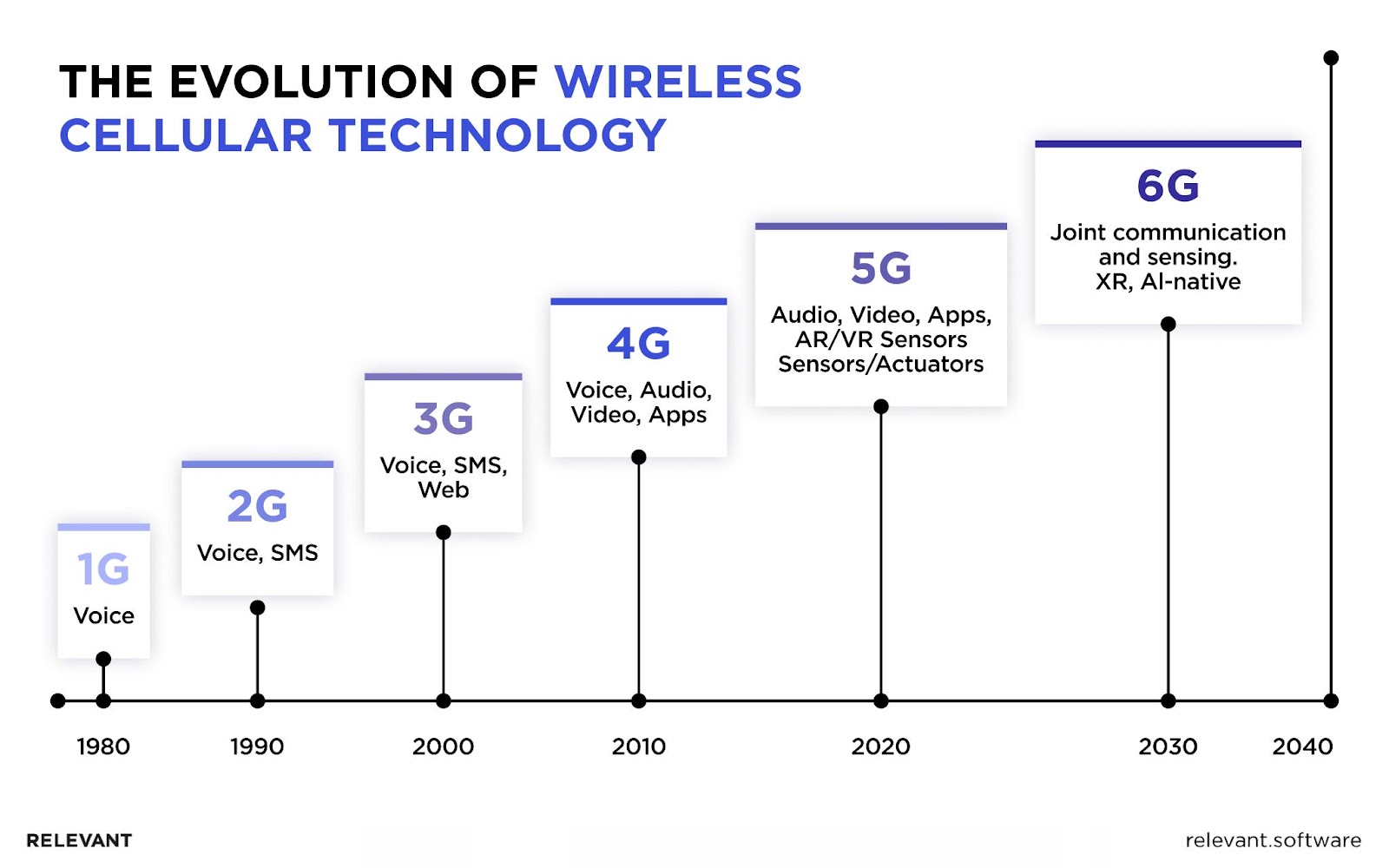
When the first connectivity standard debuted in 1980, it was limited to short-distance phone calls. There was no roaming support and security over the 1G channel, while the coverage was poor. However, at that time, it was a revolutionary technology that kickstarted the commercialization of the first mobile phones. They were bulky (38 cm long – Motorolla’s first device) and had little in common with today’s smartphones.
Then came 2G in the 1990s, introducing us to digital mobile networks and basic Internet services. The second-generation network technology improved sound quality and download speeds. Yet, a key advancement at the time that changed the way we communicate was the introduction of SMS and MMS. Mobile phones, too, have become smaller and cheaper and have found massive adoption among businesses and customers.
The 3G standard appeared in 2001, bringing faster data speeds and international roaming to start. It allowed users to access basic multimedia, surf the web, and send emails (a new standard form of communication). One of the distinctive 3G technology features was four times faster data transferring capabilities. Due to this increase, video calling through apps like Skype became possible. Although mobile phones dominated the market during the 3G era, the first smartphones emerged and quickly grew in popularity.
Introduced around 2010, 4G provided the mobile communication services we use today. Higher data speeds and lower latency of the 4G standard allowed consumers to play games online, stream videos, and enjoy high-quality video calls. These improved mobile network capabilities also enabled real-time data communication between devices, giving rise to the development of IoT devices and apps.
Each ‘G’ brought us a step closer to a more connected world, setting the stage for the next big leap – 5G.
5G – The Next Step In Mobile Network Evolution
Rolling out gradually since 2020, 5G is the latest generation of wireless connectivity that promises network transformation. It uses technology different from 4G and considerably improves coverage, latency, speed, reliability, and capacity. 5G networks can deliver from 1 Gbps (billions of bits per second) to as much as 20 Gbps in city centers, which is almost 20-30 times faster than the current 4G LTE.
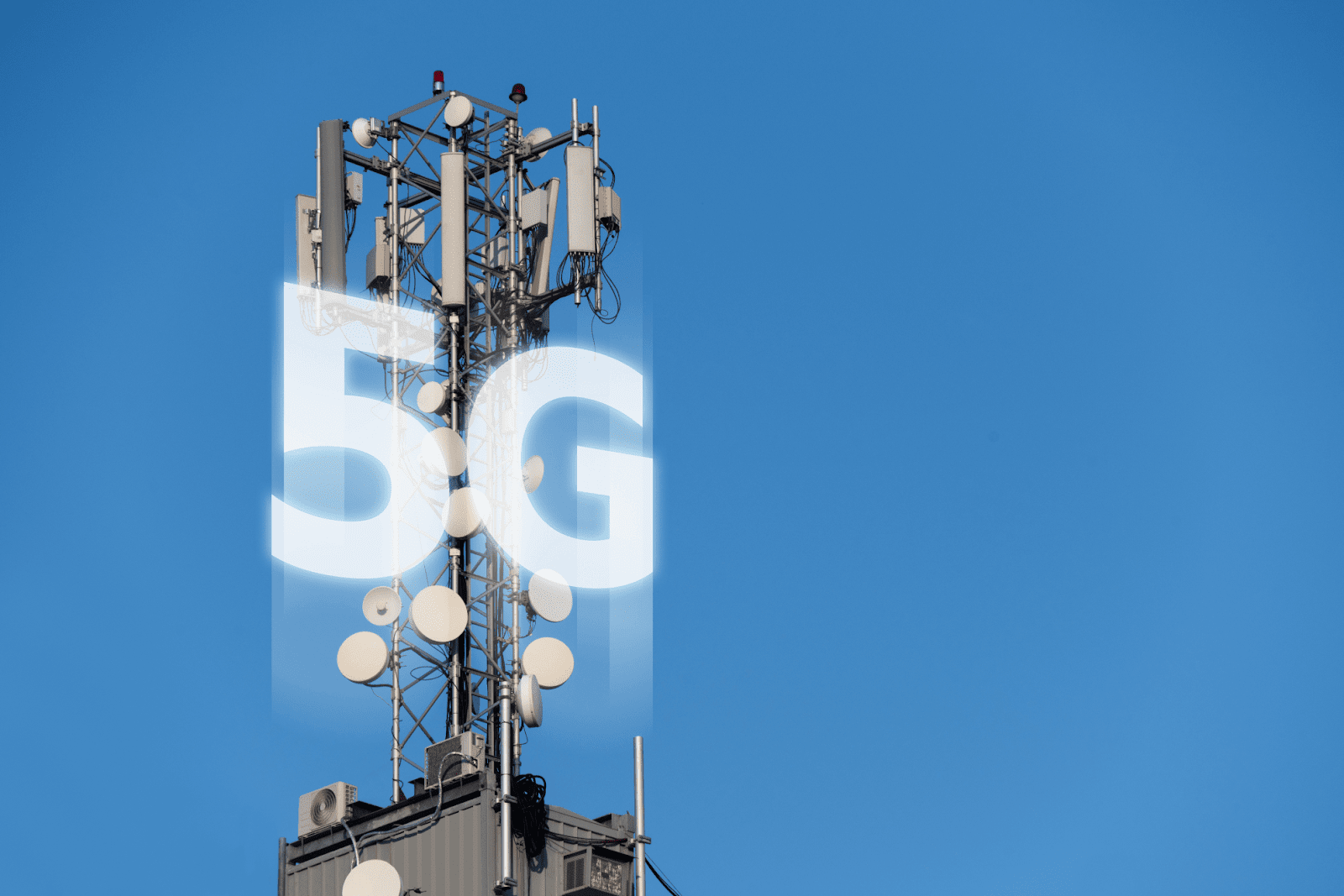
For this reason and some other advantages we’re going to review below, the 4G to 5G migration opens up the door to a world of new possibilities. 5G technology offers the necessary connectivity to support full-scale IoT architecture development (smart cities, self-driving cars) and Augmented and Virtual Reality (AR and VR) experiences. It’s also a key driver for Edge Computing technology, AI in transportation, and other industries.
So, let’s understand why migration to 5G is the inevitable future.
Benefits of 5G Migration
Companies have long been waiting for a secure and flexible connectivity solution, and 5G’s features satisfy those demands. Here are a few key benefits of 5G that will have a profound impact on businesses and their operations.
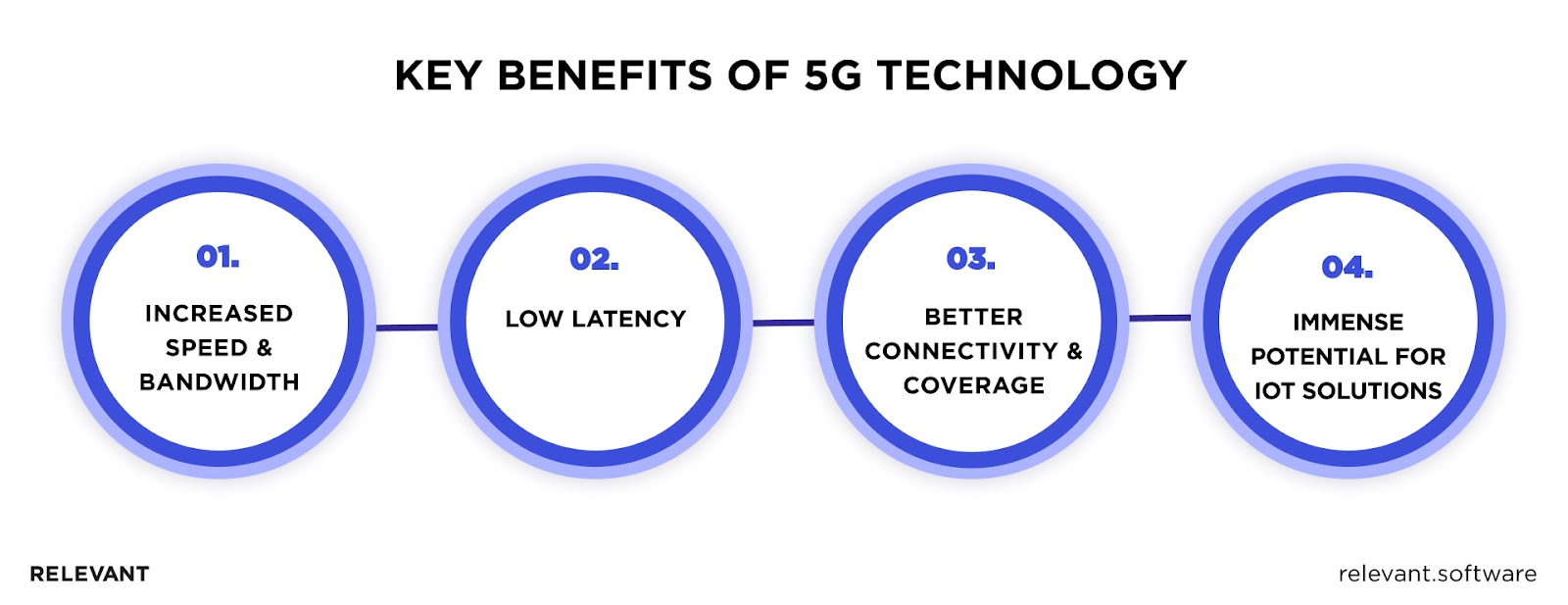
Enhanced Speed and Bandwidth
Predicted speeds of up to 20 Gbps will mean exciting possibilities for organizations and consumers. The main advantage of 5G’s greater speed and increased bandwidth, however, lies not in time savings but rather in the significantly larger amount of data that networks can transfer. With 5G connectivity and advanced data analytics, companies can turn the increasing volume of information they receive from suppliers and customers into actionable insights. Particularly, factory automation and IoT in manufacturing that require real-time data transfer will be able to achieve the desired results thanks to 5G.
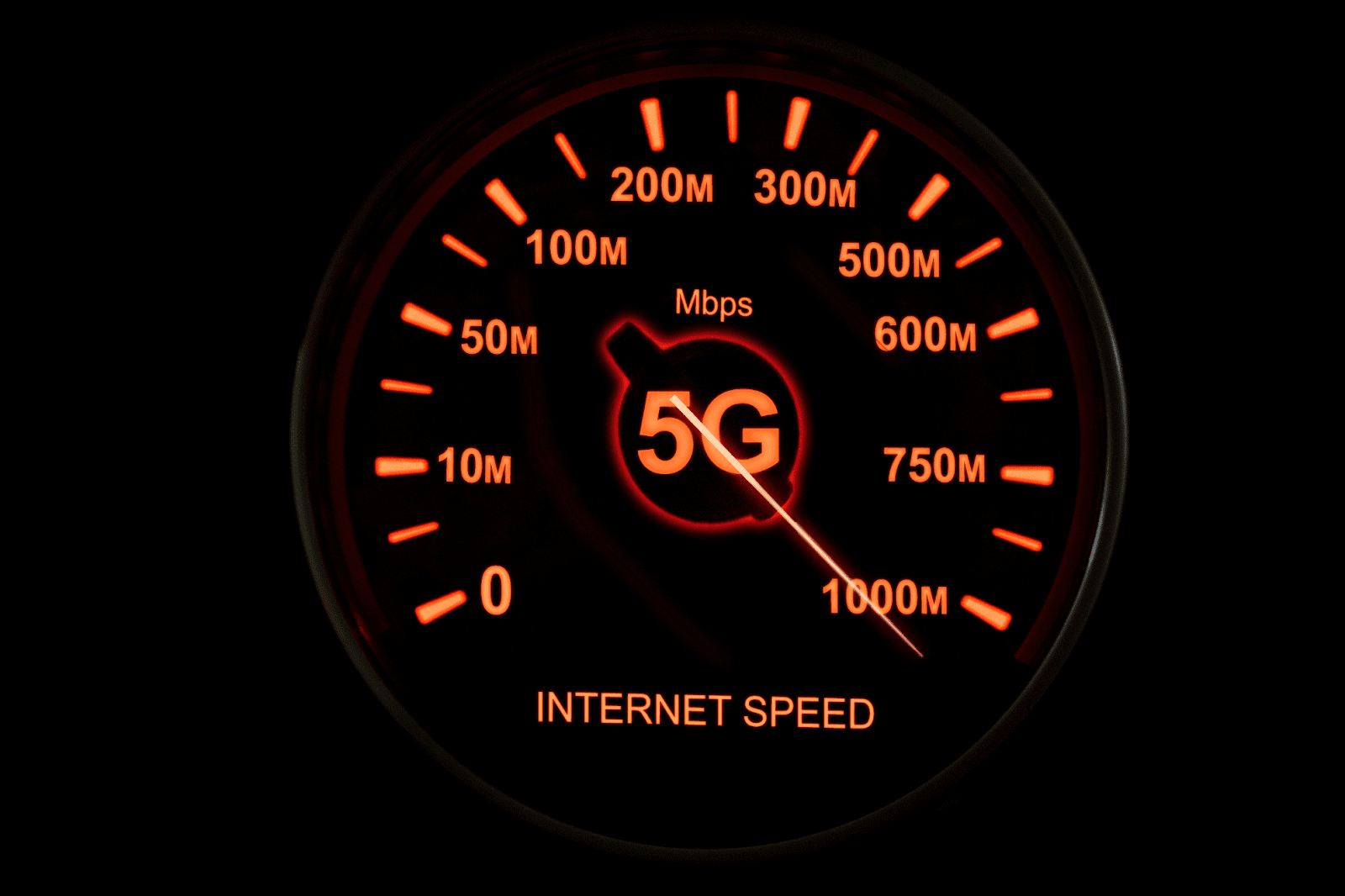
Lower Latency
The 5G network has an extremely low latency rate, the time it takes for data to move over the network from one point to another. While the latency for 4G typically ranges from 60 to 98 milliseconds (ms), the 5G standard can offer latency under 5 ms, and, ultimately, it’s to be reduced to 1 ms. So, 5G migration for businesses means support of mission-critical apps that require high responsiveness: industrial automation, remote surgery and patient monitoring, and autonomous vehicles. Faster than human visual processing (the average reaction time is 250 ms), 5G makes it possible for devices to communicate in near real-time.
Improved Connectivity and Coverage
New wireless features like multiple input, multiple output (MIMO) and evolved beamforming capabilities within 5G technology maximize network efficiency and coverage. MIMO uses multiple antennas at both the transmitter and receiver ends to facilitate strong connections over the network.
Advanced MIMO also employs beamforming algorithms to direct signals toward specific users or devices. As a result, it can extend and improve network coverage to previously unachievable locations, like deeper in the buildings, in mines, or underground. And as if it’s not enough, MIMO also lets many users share the same resources at the same time, which speaks of increased capacity. In fact, experts claim that migration from 4G to 5G will enable the network to support up to a million devices per km2.
Unlocking IoT Potential
Beyond the aforementioned increased connectivity and high speed of data transfer, 5G migration will deliver several more beneficial features that make it a perfect fit for a massive IoT deployment. The first one is network slicing, which allows you to divide a network into multiple virtual networks on a shared infrastructure and configure them for particular applications. Thus, companies can customize virtual networks by setting different latencies, resource allocation, security measures, and other parameters to align the network costs with low-power, low-band IoT app needs.
Another major upgrade that comes with 5G migration from 4G is power savings by freeing up spectrum and bandwidth. New-generation technology can reduce the power devices consume by up to 90%, simplifying IoT management and extending battery life. So, connected objects and smart sensors will be able to operate autonomously for months or even years.
Preparing for 5G Migration
Although the commercial potential of 5G networks is still in its early stages, it doesn’t mean that technology won’t impact organizations in the near future. That’s why starting to prepare your network for 5G migration is a smart move for forward-looking business leaders. So, here are some things you should do before you can introduce the fifth-gen communication technology.
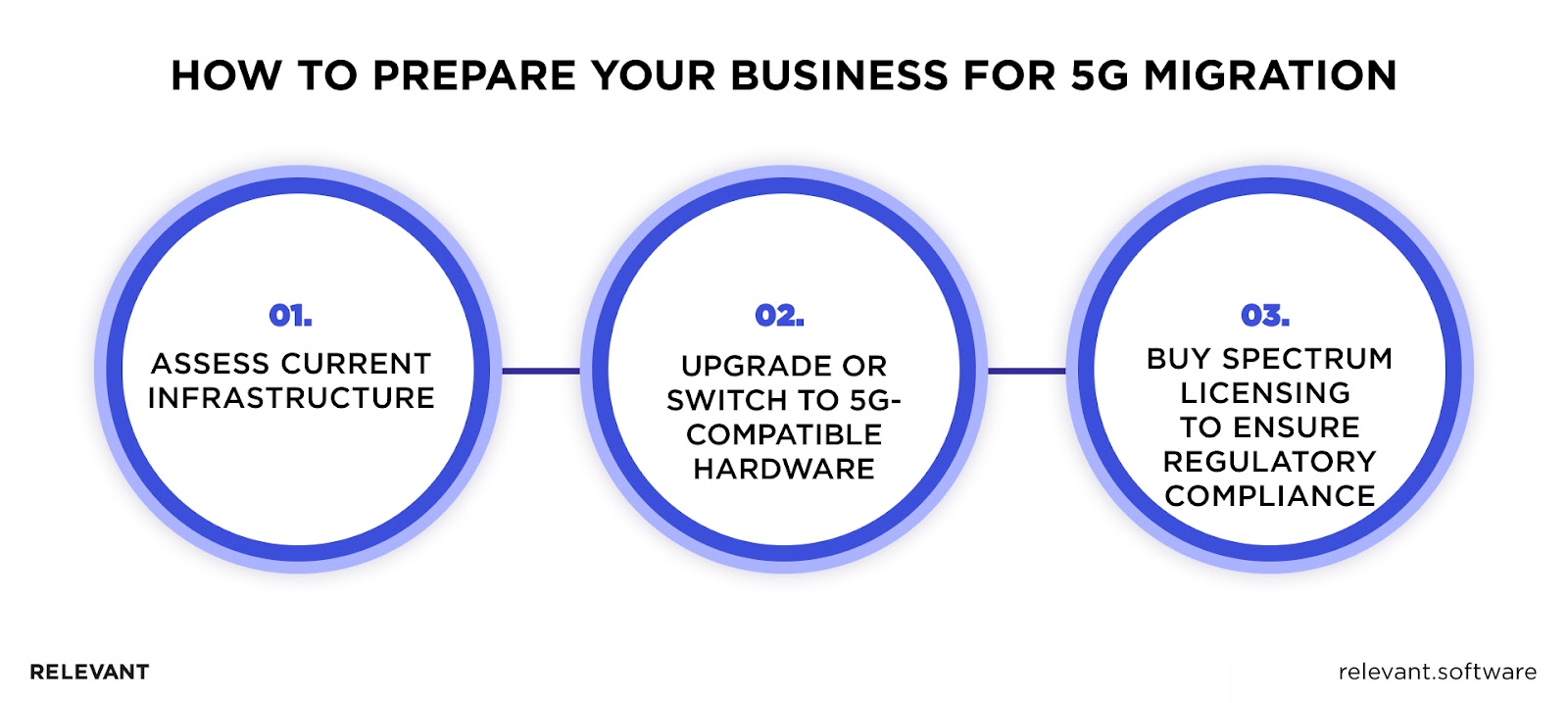
Assessing Current Infrastructure
The first thing you should do is evaluate your existing network infrastructure, paying attention to the following aspects:
- Network Coverage. Evaluate the current coverage of your network, identifying areas where 5G coverage is needed and where existing infrastructure may need to be upgraded or supplemented.
- Network Technology. Determine the current network technology in use, whether it’s 4G LTE or older generations. This will help you understand the compatibility of existing equipment and develop a thorough 5G migration strategy.
- Network Performance. Assess the current network performance, including factors like data throughput, latency, and network congestion. This evaluation will reveal the weak areas in your infrastructure that you will need to upgrade or optimize to enable 5G connectivity.
Device and Hardware Requirements
Since 5G uses different technology than its predecessors, businesses that want to leverage the promising high speeds should upgrade their hardware or switch completely to 5G-compatible devices. Here, we talk about all the equipment that may affect the performance of the fifth-gen network, including routers, antennas, laptops, smartphones, and fixed wireless access (FWA) devices if you use one. Also, if your company relies heavily on data analytics, consider adopting mobile edge computing (MEC) solutions to process data closer to the source to take the most out of the 5G connection.
Regulatory and Licensing Considerations
Regulatory and licensing requirements vary depending on the region and the specific 5G deployment scenario. So, as a business leader looking for GSM 5G migration, you should consult with local authorities and mobile network operators to understand the regulation and licensing terms regarding the deployment of a new generation network. You should be aware of the general legal aspects, especially if you plan to build a private 5G network:
- Spectrum availability. Determine the availability of 5G spectrum in your region and ensure compliance with spectrum allocation regulations.
- License Requirements. Identify the licensing requirements for 5G infrastructure and operations, including frequency licenses, equipment permits, and network operator licenses.
- Regulatory Compliance. Ensure that all 5G deployments and operations comply with relevant data privacy, security, and network neutrality regulations.
Steps of 5G Migration
Now is the time to plan for your 4G to 5G migration to take advantage of the more secure, flexible, and reliable networks. We’ve highlighted four steps for you to follow to adopt next-gen wireless technology.
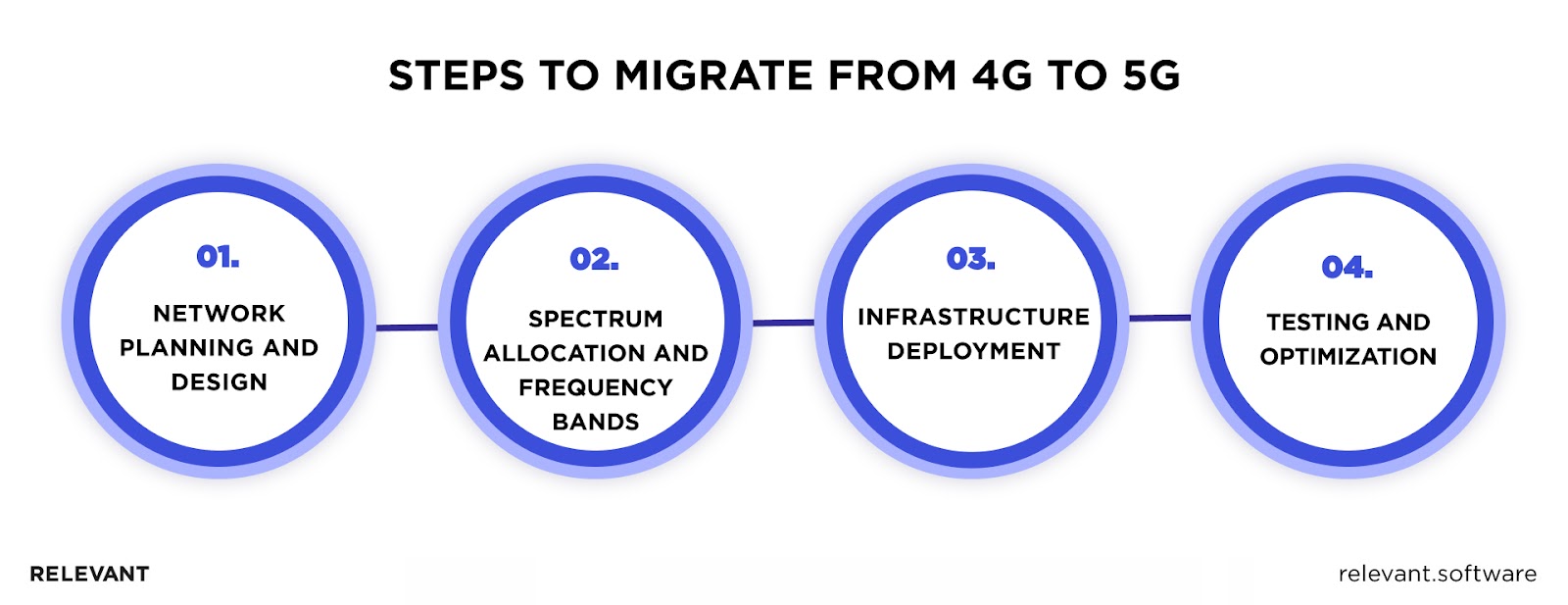
Network Planning and Design
Any changes or switches to new systems start with planning. 5G migration requires an extremely well-thought-out approach where every decision – from network coverage and capacity to functionality and scaling – reflects your targeted business goals.
5G enables various use cases demanding different requirements regarding reliability, latency, speed, capacity, etc. That’s why you should define the use case and select timelines to set priorities for the infrastructure transformation. Ask yourself: Do you need high speed for self-driving cars, zero lag for IoT connectivity, or just reliable connections for smart city sensors? Each choice shapes how you upgrade your network. That being said, capacity planning, among other things, is a critical aspect that will impact network design.
Transitioning to 5G is a strategic journey. Be ready to fine-tune your plan based on actual data and evolving needs. Don’t hesitate to partner with experts or opt for 5G migration strategy services.
Spectrum Allocation and Frequency Bands
When it comes to migration from 4G to 5G, you should take into account the architecture of the new generation wireless technology, which supports low, mid, and high-band spectrum. It gives businesses the flexibility to power highly demanding applications, but it also complicates the design of 5G networks to support all use cases. They operate on radio frequencies known as millimeter waves, or mmWave, which range from sub-1 GHz to extremely high frequencies. The higher the frequency, the more data your applications can transfer, and the lower – the farther you can send the data.
So, here are three frequency bands that form the core of 5G networks:
- Low-band has greater coverage across large areas but lower speeds, slightly faster than 4G at times. This band uses the same spectrum 4G LTE uses today, which is beneficial to provide coverage with rural job sites. For instance, companies from the energy industry will benefit from low band 5G to ensure coverage with wind farms, mining operations, and remote oil fields.
- Mid-band is considered a sweet spot between coverage and speed, transmitting around 1-6 GHz. It covers large areas enough across suburban and urban areas with speeds ranging from 100 to 900 Mbps. This band can be used in smart cities and business parks to provide continuous connection of cameras, IoT devices, and end users.
- High-band delivers the highest frequencies or mmWaves, which ensure the fastest speeds – 1 to 10 Gbps. To put it into perspective, with 1 Gbps, you can download a 4k movie in under one minute. But, high frequencies are short by nature, meaning their coverage is limited to a very small area. They can’t move through obstacles like buildings and require more cellular infrastructure to provide stable connectivity. Companies choose it to take advantage of the best 5G performance to power IoT devices and transfer massive amounts of data in near real-time.
| Low band 5G | Coverage | 600 MHz – 1 GHz |
| Mid band 5G | Capacity | 1 – 6 GHz |
| High band 5G | High speed | 6 – 24 GHz+ (mmWave) |
Infrastructure Deployment
5G migration requires investments in core infrastructure: antennas, base stations, and onboard sensors and radios. Also, limited travel distances of mmWaves demand additional installation of small cell stations to transmit signals without a hitch. For this reason, 5G deployment strategies will vary from small cells to enable fast connections over small areas and macro cell towers for large areas.
Here are the critical elements you’ll need to enable reliable low-latency communication (RLLC):
- Radio Access Network (RAN) to connect your devices to the 5G network via base stations and antennas.
- Core Network to manage data traffic, routing, and security. Businesses can create their own core network or partner with a third-party provider.
- Backhaul and Transport to provide dependable data transfer between core network components and RAN. Fiber-optic cables are commonly used for this purpose.
- Small cell stations to enhance wireless network connectivity in areas where your company needs it most and enable mmWave frequencies. They are compact and easy to install, taking no more than a few hours.
- Macrocells to provide stable, low-frequency connectivity for miles. You can use these cells atop a large tower near your location. It’s the fastest way to benefit from 5G deployment.
New-generation network deployment includes months of planning for the placement of RANs, small cells, and other equipment to ensure the best possible performance and coverage. Here, the expertise of professionals or 5G migration strategy services may help you with preparation and planning. Once you’re sure of the viability of your network design, deploy your network components, which usually involve physical equipment installation and configuration. Taking a phased approach to network deployment based on non-standalone (NSA) and standalone (SA) architectures is a smart idea, as it allows a smooth switch without disrupting your operations.
Testing and Optimization
Before you fully deploy the 5G network, it’s crucial to perform thorough testing to make sure it offers the reliability and performance you were expecting. Test your network for signal strength, latency, data throughput, and speed. Based on the test results, make the required network optimization or other adjustments to ensure peak performance.
Challenges of 5G Migration
Although the 5th generation wireless technology is more advanced than its predecessors, switching to new infrastructure and managing security is rarely an easy task. Here are some of the 5G issues and challenges enterprises should consider before building new or upgrading current wireless networks:
- Infrastructure Overhaul
5G’s higher frequencies can transmit more data but struggle to penetrate buildings and travel long distances compared to 4G. To achieve its promised coverage and capacity, the installation of a greater number of cell sites is required. Another aspect to consider is interoperability between different generations of networks because 5G will coexist with 4G for about a decade.
- High Initial Costs
Every stage of implementing 5G technology, from obtaining spectrum bands to locating cell tower locations and installing extensive fiber optic cables, comes at a high expense. Companies also have to replace legacy equipment and network components with those that are 5G compatible. The high deployment costs may also increase the service costs for customers.
- Security Concerns
While 5G networks are inherently more secure than 4G, the fact that they support more connected devices and users, as well as more complex infrastructure, opens more opportunities for attackers to exploit. There are also 5G challenges regarding its reliance on cloud and virtualization that can introduce new weak points in the network. Lastly, the 5th-generation mobile technology lacks end-to-end encryption itself, which opens gaps early in the connection process and leaves room for attack. That’s why it’s really critical to build robust cybersecurity solutions to protect the network and data it carries.
The Future of 5G and Beyond (Potential for 6G)
5G is more than faster internet or quicker downloads, it’s about innovation and new business capabilities. What we can expect next from this technology will depend on how successfully companies will be able to leverage 5G benefits to power AI and ML-driven applications and data analytics in their operations. What’s more, 5G Advanced, arriving in 2024, brings extended reality communication to the scene, blurring the lines between physical and digital experiences. So, the future of 5G is bright and holds wide potential.
Along with that, the industry is working on the 6G mobile technology promising terabit-per-second speeds and transformative applications in imaging, virtual presence, and hyper-accurate location awareness. It will be built on top of 5G’s infrastructure but offer more capabilities and smarter networks.
5G Migration: Final Thoughts
5G is here, and it’s already changing how businesses operate, offer services, and treat their customers. It’s reliable and fast, but most importantly, it provides exciting new use cases for IoT deployment and usage that 4G can’t deliver. The government IoT sectors, manufacturers, transportation companies, and businesses looking for IoT software development services to drive innovation will benefit a lot from 5G migration.
Our core services:
Do you want a price estimate for your project?
Do you know that we helped 200+ companies build web/mobile apps and scale dev teams?
Let's talk about your engineering needs.
Write to us











